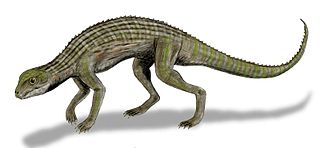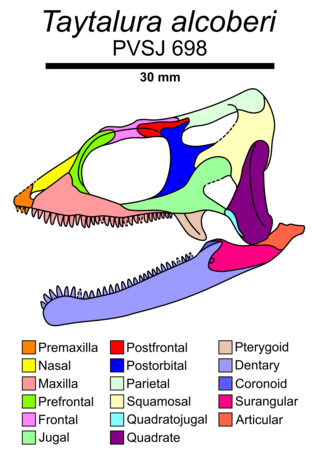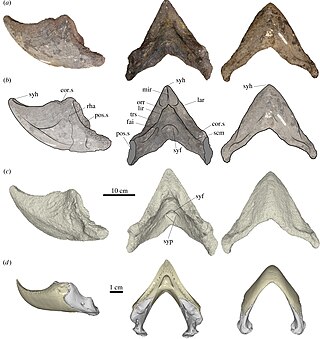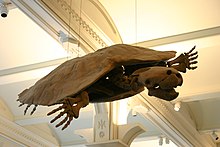
Podocnemididae is a family of pleurodire (side-necked) turtles, once widely distributed. Most of its 41 genera and 57 species are now extinct. Seven of its eight surviving species are native to South America: the genus Peltocephalus, with two species, only one of which is extant ; and the genus Podocnemis, with six living species of South American side-necked river turtles and four extinct. There is also one genus native to Madagascar: Erymnochelys, the Madagascan big-headed turtle, whose single species E. madagascariensis.

Baru, sometimes referred to as the cleaver-headed crocodile, is an extinct genus of Australian mekosuchine crocodilian. Its fossils have been found from various Late Oligocene and Miocene localities from across the Northern Territory and Queensland, indicating that Baru was a common genus during the late Paleogene and early Neogene. Three species are recognized, B. darrowi, B. iylwenpeny, and B. wickeni.

Paranthodon is a genus of stegosaurian dinosaur that lived in what is now South Africa during the Early Cretaceous, between 139 and 131 million years ago. Discovered in 1845, it was one of the first stegosaurians found. Its only remains, a partial skull, isolated teeth, and fragments of vertebrae, were found in the Kirkwood Formation. British paleontologist Richard Owen initially identified the fragments as those of the pareiasaur Anthodon. After remaining untouched for years in the British Museum of Natural History, the partial skull was identified by South African paleontologist Robert Broom as belonging to a different genus; he named the specimen Palaeoscincus africanus. Several years later, Hungarian paleontologist Franz Nopcsa, unaware of Broom's new name, similarly concluded that it represented a new taxon, and named it Paranthodon owenii. Since Nopcsa's species name was assigned after Broom's, and Broom did not assign a new genus, both names are now synonyms of the current binomial, Paranthodon africanus. The genus name combines the Ancient Greek para (near) with the genus name Anthodon, to represent the initial referral of the remains.

Stupendemys is an extinct genus of freshwater side-necked turtle, belonging to the family Podocnemididae. It is the largest freshwater turtle known to have existed, with a carapace over 2 meters long. Its fossils have been found in northern South America, in rocks dating from the Middle Miocene to the very start of the Pliocene, about 13 to 5 million years ago. Male specimens are known to have possessed bony horns growing from the front edges of the shell and the discovery of the fossil of a young adult shows that the carapace of these turtles flattens with age. A fossil skull described in 2021 indicates that Stupendemys was a generalist feeder.
Mesosuchus is an extinct genus of basal Rhynchosaur from early Middle Triassic deposits of Eastern Cape, South Africa. It is known from the holotype SAM 5882, a partial skeleton, and from the paratypes SAM 6046, SAM 6536, SAM 7416 and SAM 7701 from the Aliwal North Euparkeria site. Mesosuchus is quite small, spanning around 30 cm in length. Mesosuchus was discovered and named by David Meredith Seares Watson in 1912.

Adamantinasuchus is an extinct genus of notosuchian crocodylomorph from and named after the Late Cretaceous Adamantina Formation of Brazil. It is known from only one fossil, holotype UFRJ-DG 107-R, collected by William Nava. The fossil consists of a partial skull, fragmentary limb bones and a few broken vertebrae, and was found 25 kilometres (16 mi) southwest of the town of Marilia, near a reservoir dam. Adamantinasuchus was approximately 60 centimetres (24 in) long from nose to tail, and would have only weighed a few kilograms.
Calsoyasuchus is a genus of crocodylomorph that lived in the Early Jurassic. Its fossilized remains were found in the Sinemurian-Pliensbachian-age Kayenta Formation on Navajo Nation land in Coconino County, Arizona, United States. Formally described as C. valliceps, it is known from a single incomplete skull which is unusually derived for such an early crocodile relative. This genus was described in 2002 by Ronald Tykoski and colleagues; the specific name means "valley head" and refers to a deep groove along the midline of the nasal bones and frontal bones. It has often been interpreted as the earliest diverging member of Goniopholididae, but other studies have recovered it in various other positions.

Plesiotylosaurus, meaning "near Tylosaurus", is an extinct genus of marine lizard belonging to the mosasaur family. It is classified as part of the Mosasaurinae subfamily, alongside genera like Mosasaurus and Prognathodon. The genus contains one species, Plesiotylosaurus crassidens, recovered from deposits of Middle Maastrichtian age in the Moreno Formation in California.

Daemonosaurus is an extinct genus of possible theropod dinosaur from the Late Triassic of New Mexico. The only known fossil is a skull and neck fragments from deposits of the latest Triassic Chinle Formation at Ghost Ranch. Daemonosaurus was an unusual dinosaur with a short skull and large, fang-like teeth. It lived alongside early neotheropods such as Coelophysis, which would have been among the most common dinosaurs by the end of the Triassic. However, Daemonosaurus retains several plesiomorphic ("primitive") traits of the snout, and it likely lies outside the clade Neotheropoda. It may be considered a late-surviving basal theropod or non-theropod basal saurischian, possibly allied to other early predatory dinosaurs such as herrerasaurids or Tawa.
Eremiasaurus is a genus of mosasaurs, an extinct group of marine reptiles. It lived during the Maastrichtian stage of the Late Cretaceous in what is now North Africa. Only one species is known, E. heterodontus, described in 2012 from two remarkably complete fossil specimens discovered in the Ouled Abdoun Basin, Morocco. This site is known to have delivered a significant number of other related mosasaurs.
Brontochelys is an extinct genus of podocnemidid from the Miocene of Pakistan. The only species known, B. gaffneyi was classified before in the genus Shweboemys, which is known from the Pliocene of Burma. Brontochelys is represented only by its type specimen BMNH R.8570, a nearly complete skull, which exact locality is unknown but probably comes from the Lower Miocene sediments in the Bugti Hills, in Baluchistan, Pakistan. This skull is different from its relatives like Shweboemys, Lemurchelys and Stereogenys by its large, forward-faced orbits, a large frontal bone that composes most of the dorsal orbit margin and a palatal curved. The name of Brontochelys is formed by the Greek words bronte, "thunder" and chelys, "turtle", in reference to the large size of the skull.

Carbonemys cofrinii is an extinct giant podocnemidid turtle known from the Middle Paleocene Cerrejón Formation of the Cesar-Ranchería Basin in northeastern Colombia. The formation is dated at around 60 to 57 million years ago, starting at about five million years after the KT extinction event.

Palatodonta is an extinct genus of neodiapsid reptile known from the early Middle Triassic of the Netherlands. It was initially described in 2013 as a basal placodontiform closely related to a group of marine reptiles called placodonts, characterized by their crushing teeth and shell-like body armor. Under this interpretation, Palatodonta is transitional between placodonts and less specialized reptiles. Like placodonts, it has a row of large teeth on its palate, but while these teeth are thick and blunt in placodonts, Palatodonta has palatal teeth that are thin and pointed. A 2023 study instead classified it as a sauropterygomorph and the sister taxon to Eusaurosphargis. In other words, it is close to, but not within, Sauropterygia.
Caiman brevirostris is an extinct species of caiman that lived during the Late Miocene, around 11.6 million years ago, to the end of the Miocene 5.3 million years ago in Acre and Amazonas, Brazil as well as Urumaco, Venezuela. Several specimens have been referred to the species, but only 3 of them are confidently placed in the species. C. brevirostris was originally named in 1987 on the basis of a single, incomplete rostrum with an associated mandibular ramus that had been found in Acre, Brazil. C. brevirostris is very distinct among Caiman species and caimaninae overall in that it preserves a characteristically short and robust skull that bears blunt posterior teeth that were built to break down harder foods. This was an adaption for durophagy, likely to crush shells of mollusks and clams which were common in the wetlands that C. brevirostris resided in.
Azabbaremys is an extinct genus of bothremydid pleurodiran turtle that was discovered in the Teberemt Formation of Mali. It was described in 2001, based on a skull that had been recovered in an expedition in 1981. The genus consists solely of the type species Azabbaremys moragjonesi. The genus name is derived from Azabbar, a monster in Tamasheq folk stories. The species is named for Morag Jones, a research student who participated in the discovery of the specimen and died in the expedition. Azabbaremys is most closely related to another Paleocene side-necked turtle, Acleistochelys.

Sahonachelys is an extinct genus of pelomedusoid turtle from the Late Cretaceous (Maastrichtian) Maevarano Formation of Madagascar. The genus contains a single species, Sahonachelys mailakavava.

Taytalura is an extinct genus of lepidosauromorph reptile from the Late Triassic of Argentina. It contains a single species, Taytalura alcoberi, which is based on a well-preserved skull from the fossiliferous Ischigualasto Formation. As a lepidosauromorph, Taytalura is a distant relative of modern lepidosaurs such as sphenodontians and squamates. Taytalura did not belong to any group of modern lepidosaurs, since it bears unique features, such as unfused bones in the skull roof and teeth which all sit loosely in a deep groove without sockets. Regardless, Micro-CT scanning reveals features of the skull previously only seen in rhynchocephalians. This suggests that the ancestral condition of the skull in lepidosaurs was more similar to sphenodonts than to squamates.

Kalthifrons is an extinct monospecific genus of mekosuchine crocodylian known from the Pliocene Tirari Formation of Australia. More specifically, Kalthifrons was recovered from the Mampuwordu Sand Member, which underlies the younger sediments of the Pompapillina Member. This is significant, as the latter preserves some of the earliest records of the genus Crocodylus in Australia, which would eventually go on to replace mekosuchines. It is currently unclear whether or not the Tirari Crocodylus directly outcompeted Kalthifrons or simply moved into the region after the niche was left empty by the extinction of the local mekosuchines. Should the later be the case, then Kalthifrons may have simply been the victim of global cooling and aridification. A point in favour of the competition hypothesis is that both Kalthifrons and the Tirari Crocodylus have broadly similar skull forms, with both being interpreted as generalist semi-aquatic predators much like many of today's crocodiles. Though far from large, Kalthifrons was nonetheless bigger than many other mekosuchines such as Trilophosuchus and Mekosuchus. The genus is monotypic, meaning it contains only a single species, Kalthifrons aurivellensis.

Kyhytysuka is an extinct genus of ophthalmosaurian ichthyosaur from Early Cretaceous Colombia. The animal was previously assigned to the genus Platypterygius, but given its own genus in 2021. Kyhytysuka was a mid-sized ophthalmosaurian with heterodont dentition and several adaptations suggesting that it was a macropredatory vertebrate hunter living in shallow waters. It contains a single species, Kyhytysuka sachicarum.

Peltocephalus maturin is an extinct species of podocnemidid river turtle closely related to the big-headed Amazon River turtle that lived during the Late Pleistocene and Early Holocene in what is now Brazil. P. maturin is known from a singular lower jaw of enormous size, with estimates suggesting its carapace may have reached lengths of around 1.70 m. This would make it one of the largest freshwater turtles in history, comparable in size to the Paleocene podocnemidid Carbonemys and only exceeded by the Miocene podocnemidid Stupendemys. Like its closest relative, it was likely an omnivore, the narrow cutting surface of its lower jaw unsuited for strict herbivory or durophagy.
















